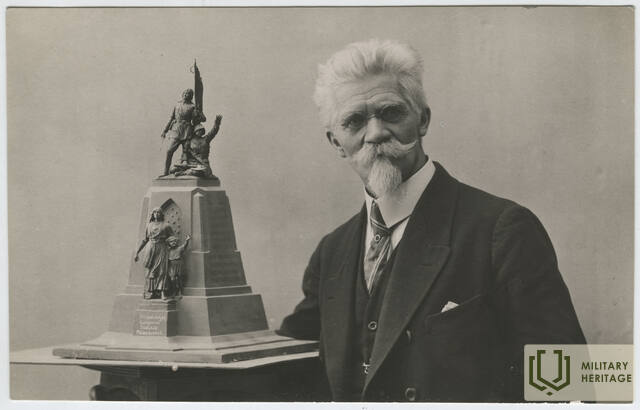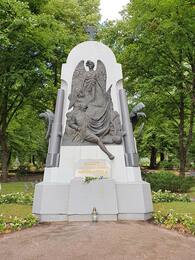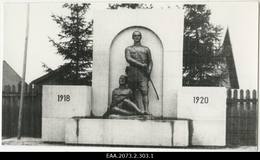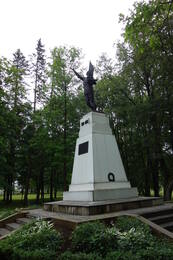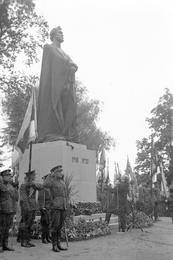Amandus Adamson (1855–1929)
I Nepriklausomybės karai
Estų skulptorius, akademikas ir vienas iš Estijos nacionalinio meno pradininkų.
Amandus Heinrich Adamson gimė 1835 m. lapkričio 12 d. Pakri pusiasalyje. Jo meninis talentas buvo atrastas anksti – manoma, kad pirmąją medinę figūrėlę jis išdrožė broliui dar prieš išmokdamas skaityti.
Nepaisant kuklios kilmės ir daugybės nesėkmingų bandymų įstoti, Adamsonui 1876 m. pavyko įstoti į Sankt Peterburgo dailės akademiją kaip kviestiniam studentui, kurią 1879 m. baigė sidabro medaliu. Vėliau jis tapo laisvai samdomu menininku Sankt Peterburge ir netrukus pradėjo gauti užsakymus iš aristokratų ir net valdovo šeimos. 1887 m. balandžio 8 d. jis atidarė savo pirmąją personalinę parodą Sankt Peterburge. Adamsonas gyveno Paryžiuje nuo 1887 iki 1891 m. – tai buvo meniškai produktyvus laikotarpis, per kurį jis lavino savo stilių. 1889 m. jis pateikė du savo darbus pasaulinei parodai Paryžiuje ir laimėjo apdovanojimą.
1901 m. Adamsonas ėmėsi monumentalių skulptūrų kūrimo. Pirmasis jo užsakymas buvo Rusijos karo laivo „Russalka“ nuskendimo paminklas Taline (1902 m.) – pirmasis estų skulptoriaus paminklas Estijoje.
1907 m. Adamsonas tapo Sankt Peterburgo dailės akademijos akademiku ir dėstė daugelį, tarp kurių buvo garsūs estų menininkai Nikolajus Triikas ir Konradas Mägi.
Prasidėjus Rusijos revoliucijai, Adamsonas grįžo į Estiją ir apsigyveno Paldiski mieste, vėliau retkarčiais gyveno ir dirbo Italijoje.
Jo darbai yra neobarokinio stiliaus su realistine įtaka ir dažnai yra alegoriniai. Suprojektavo daug Nepriklausomybės karo paminklų (Pernu, Valgoje, Rakverėje, Narva-Jõesuu, Viljandi, Suure-Jaani, Kuresarėje, Kalevipoego statula Tartu mieste prie Emajogi upės).
Adamsonas mirė 1929 m. birželio 26 d. savo namuose Paldiski. Jis palaidotas šalia jo paties suprojektuoto Nepriklausomybės karo paminklo Pernu. Adamsonų šeima 2005 m. padovanojo menininko vasaros studiją Paldiski Estijos vyriausybei. 2010 m. ten, kaip Harjumaa muziejaus filialas, buvo atidarytas Amanduso Adamsono studijos muziejus.
Susijusios vietos
Pernu Laisvės kovų paminklas
Šį paminklą suprojektavo Amandus Adamson. Jis buvo atidengtas Alevi kapinėse Pernu mieste 1922 m. liepos 16 d. Jo autorius buvo palaidotas šalia 1929 m.
1945 m. balandžio 15 d. paminklas buvo susprogdintas į šipulius, kurie vėliau buvo palaidoti. Berniuko su girlianda statulą už 175 metrų nuo paminklo palaidojo vietos vidurinės mokyklos mergaitės. Laimei, kareivių kapai liko nepaliesti.
Įgulos kapinės buvo atnaujintos 1987 m., o paminklo dalys (įskaitant berniuko su girlianda statulą) buvo atkastos 1988 m. 1989 m. vasario 24 d. buvo atidengta viršutinė paminklo dalis, kuri buvo rasta palaidota originalioje vietoje, su granito lentele su užrašu: „1918 1920 / ČIA BUVO ATIDENGTAS, 1922 M. LIEPOS 16 D. PAMINKLAS / ŽUVUSIEMS NEPRIKLAUSOMYBĖS KARE / SKULPTURIUS AMANDUS ADAMSON / SUNAIKINTAS 1945 M. / 1989 M. II 24 D.“ Paminklo ir kapinių restauravimas buvo atliktas etapais. Paminklas iš naujo atidengtas 1993 m. liepos 17 d.
Nepriklausomybės karo paminklas Šv. Pauliaus kapinėse
Šis paminklas yra Tartu Šv. Pauliaus kapinių šiauriniame kampe.
Skulptoriaus Aleksandro Ellerio ir miesto architekto Arnoldo Matteuso sukurtas paminklas vaizduoja du Amanduso Adamsono sukurtus kareivius ir buvo atidengtas 1934 m. lapkričio 11 d. Sovietų okupacijos metu skulptūros ir datos buvo pašalintos iš paminklo. 2015 m. spalio 10 d. toje pačioje vietoje buvo atidengtas Nepriklausomybės karo memorialas, kurį sudaro Mati Karmino skulptūra „Kalevas ir Linda“ bei Mati Karmino ir Tiito Trummalo suprojektuota iškilmių aikštė su takais, parko suoliukais ir kryptinėmis šviesomis. Paminklas žymi masinę 254 Nepriklausomybės karo metu žuvusių karių kapavietę.
Nepriklausomybės karo paminklas Valgoje
Šis paminklas, skirtas atminti Pietų Estijos laisvės kovotojus, vaizduoja nežinomo kareivio statulą, vienoje rankoje laikantis vėliavą, o kitą – ištiesęs. Jis stovi ant aukšto pjedestalo. Originalus paminklas buvo atidengtas 1925 m. spalio 11 d., minint leitenanto Juliaus Kuperjanovo 31-ąjį gimtadienį, tačiau 1940 m. rugsėjo 21 d. naktį jį nugriovė sovietų režimas. Jis buvo iš naujo atidengtas originalioje vietoje Kuperjanovi gatvėje Valgoje 2013 m. rugpjūčio 16 d. Originalų paminklą 1925 m. suprojektavo Amandus Adamsonas, kuris taip pat prižiūrėjo bronzinės skulptūros liejimą Italijoje. Skulptorius Jaakas Soansas ją restauravo iki pilno dydžio. Restauravimą organizavo ne pelno siekianti organizacija VIKP (Nuolatinė Valgos patriotinio auklėjimo paroda), Valgos miesto ir apskrities valdžia bei Estijos karo muziejus.
Nepriklausomybės karo paminklas Tartu mieste
Šis paminklas yra dešiniajame Emajegio upės krante, prie Vabaduse prospekto (tarp Vabaduse ir Kaarsilla tiltų), Tartu mieste.
Amanduso Adamsono suprojektuotas paminklas buvo atidengtas 1933 m. rugsėjo 17 d. ir jame buvo bronzinė estų epo didvyrio Kalevipoego, besiremiančio į savo kardą, skulptūra. Paminklas buvo pašalintas 1950 m., tačiau žmonėms ir toliau nešant į šią vietą gėlių ir žvakių, 1952 m. buvo atidengtas rašytojo Friedricho Reinholdo Kreutzwaldo biustas. Restauruotas paminklas, kurį pagal senas nuotraukas sukūrė skulptorius Ekke Väli, buvo atidengtas 2003 m. birželio 22 d.




